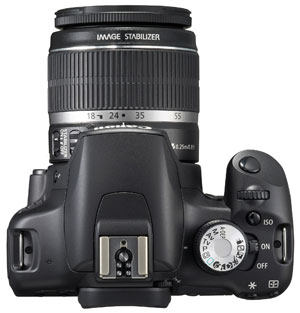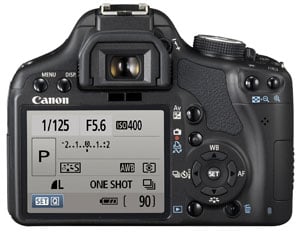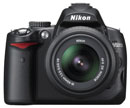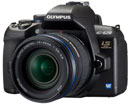Canon EOS 500D / Rebel T1i
-
-
Written by Gordon Laing
Canon EOS 500D / Rebel T1i verdict
Canon’s EOS 500D / Rebel T1i is a feature-packed DSLR which boasts a wide variety of improvements over its predecessor, the best-selling EOS 450D / Rebel XSi. Like many new DSLRs, the 500D / T1i inherits a number of features from a higher-end model in the range, but packages them into a smaller lighter and more affordable form factor with at least one key advantage.
In this case, the semi-pro EOS 50D provides much of the inspiration, with the same sensor resolution, ISO range, screen, HDMI port, Creative Auto mode, DIGIC 4 processor, highlight protection and peripheral correction just for starters. While there are technical differences between their sensors, both bodies shared essentially the same resolving power in our tests along with similar noise levels throughout most of the sensitivity range; the 50D’s gapless micro-lenses give it a slight advantage above 800 ISO, but the 500D / T1i wasn’t far behind.
Like the EOS 50D though, the fine pixel-pitch of a 15 Megapixel APS-C sensor demands decent optics to fully exploit it. In areas of the frame where the kit lens performs well, you’ll enjoy plenty of fine detail, but in other areas, you’d be hard pushed to notice much difference with a 12 Megapixel model. Even when fitted with a decent lens, the differences can be subtle, so our advice wouldn’t be to choose the 500D / T1i over a rival model based on resolution alone.
It should also be noted the 12 Megapixel sensors in Nikon’s D5000 and D90 models delivered cleaner and more detailed results at higher sensitivities in our tests. So if you mostly shoot at low ISOs with decent lenses, there can be a detail advantage to the 500D / T1i over its rivals, but as you increase the sensitivity, models like the two Nikons take the lead. See our High ISO results page for full details.

 |
The 3in VGA screen, also inherited from the EOS 50D is a decent upgrade over the 230k model on the earlier 450D / XSi. It may be the same size and make no difference to the final quality, but the finer screen resolution makes images in playback look wonderful, and by exploiting the full resolution in Live View, it can also help with precision focusing.
On the other hand, rivals like the Nikon D5000 and Olympus E-620 may employ smaller and less detailed screens, but they’re fully-articulated, allowing you to comfortably compose in Live View at unusual angles. There’s a caveat here that focusing in Live View on any of these cameras is normally too slow to capture action shots, but we still found the flexibility invaluable. Again it boils down to how you intend to use the camera: if you can see yourself regularly framing static subjects at low or high angles, then the flip-out screens are a wonderful ally, but if you’re into precision focusing in Live View and playback on the camera’s own screen, you’ll love the size and detail of the Canon.
The headline feature of the EOS 500D / T1i is of course its new HD movie mode. Like all DSLRs to date with video capabilities, there’s a wealth of caveats that prevent it from ever being a true replacement for a camcorder (such as lack of practical autofocus and manual control), but if you’re willing to work-around them and embrace the advantages, you can achieve some great results.
There were however three additional operational caveats beyond the EOS 5D Mark II that you should know about. First, the ‘Full HD’ 1080p mode shoots at 20fps, which is just a little too slow for smooth action, and as such, the 500D / T1i should only really be described as a 720p model. Secondly, the 1080p mode requires a fast SD card to record more than a few seconds of footage. And third, there’s no option to connect an external microphone, so you will inevitably pick-up the sound of the lens stabilisation or any adjustments to the focusing and zoom rings.
It should also be noted the standard EF-S 18-55mm IS lens is far from ideal for video work. The manual focusing ring perched at the end of the lens is unsuitable for adjustment while filming, while the relatively slow focal ratio means you’ll miss out on the shallow depth-of-field effects and low light performance which make video with a DSLR a compelling proposition. So if you’re serious about video, get yourself an older lens with a bright focal ratio and a manual aperture ring. There’s full details on our Movie Mode page.
Before moving on, we should also mention we experienced an above average number of shots with focusing errors while testing our 500D / T1i kit. This appeared to be down to the kit lens supplied as switching to another improved the situation, but we’d still recommend any buyers to run some tests before their warranty expires. It’s also worth noting that even when images are perfectly in focus, the 500D / T1i delivers relatively soft images from in-camera JPEGs. This may be appropriate for the higher-end 50D, where owners are likely to post-process, but the 500D / T1i’s typical audience may prefer punchier images out of the camera. If this sounds like you, we’d recommend boosting the in-camera processing options.
Now let’s see how the new EOS 500D / T1i compare to its predecessor and the higher-end EOS 50D, along with its two major rivals, the Nikon D5000 and Olympus E-620…
Compared to Canon EOS 450D / Rebel XSi
Physically speaking the new EOS 500D / T1i shares a great deal with its predecessor, the best-selling EOS 450D / XSi. They share the same dimensions, virtually the same weight (the new model’s 5g heavier), the same viewfinder and AF specification, and even the same battery (albeit now with 20% shorter life). The continuous shooting speed is also virtually the same, although the new model makes up for fractionally slower speed with a larger frame burst. In its favour, the new EOS 500D / T1i boasts an extra three Megapixels, a much more detailed VGA monitor, an HDMI port, a much higher maximum sensitivity of 12800 ISO compared to just 1600 on its predecessor, Peripheral Illumination Correction to reduce the corner darkening of lens vignetting, the Creative Auto mode, and of course the headline feature of HD video recording. In our tests, we didn’t notice much difference in terms of real-life detail, especially when the 500D / T1i was fitted with the standard EF-S 18-55mm IS kit lens, although there’s the potential for superior resolving power if you fit better optics. Noise levels were similar at lower sensitivities, although at 800 and especially 1600 ISO, the 500D / T1i avoids the chroma artefacts of its predecessor. But in terms of overall image quality, there’s not much in it.
So you should really only choose the 500D / T1i over the 450D / XSi if you’re either coupling it with decent lenses, or value its new features, like the HD Movies and VGA screen. If you’re not bothered by the movies or screen and intend to use the kit lens, then save yourself some money and go for the older 450D / XSi. It remains an excellent DSLR which is likely to fall in price further as stocks last. See our Canon EOS 450D / XSi review for more details. |
Compared to Canon EOS 50D
The EOS 500D / T1i shares a number of features in common with the higher-end 50D, including the same sensor resolution, ISO range, 3in VGA screen, HDMI port, Creative Auto mode, DIGIC 4 processor, highlight protection and peripheral correction just for starters. But a number of key differences remain which justify the 50D’s higher price tag. Most obviously, the EOS 50D’s body is much tougher and sports greater weather-proofing along with an upper LCD information screen and a PC sync port for external lighting. It employs a penta-prism viewfinder with a bigger, brighter view. Continuous shooting is almost twice as fast at 6.3fps. There’s AF micro-adjustment to compensate for front or back-focusing. And while the resolution and ISO range are the same, the 50D employs gapless microlenses for slightly superior performance at higher sensitivities; the sensor additionally employs a Fluorine coating described to better resist dust, although in our tests the 50D and 500D / T1i performed similarly in that respect. In its favour, the 500D / T1i is smaller and lighter, while boasting the one major feature bizarrely missing from the 50D: HD movie recording. As described above, there’s a ton of caveats to consider, but it remains a headline advantage over its higher-end counterpart. And crucially the EOS 500D / T1i is comfortably cheaper too. Ultimately if you want a camera that’s tougher and quicker, along with sporting more professional features, the 50D offers a great deal beyond Canon’s latest. See our Canon EOS 50D review for more details. |
Compared to Nikon D5000
Nikon’s D5000 is undoubtedly the biggest rival for Canon’s EOS 500D / T1i, with both sharing HD movie modes, HDMI ports and similar price tags. There are however a number of differences between them to weigh-up. At first glance, the Canon EOS 500D / T1i appears to trump the D5000 in a number of key specifications: the resolution is higher (15.1 Megapixels versus 12.3), the maximum sensitivity is higher (12800 ISO compared to 6400), tonal depth is greater (14 bits versus 12), the screen is bigger and more detailed (3in VGA vs 2.7in QVGA), the viewfinder slightly larger and the headline movie mode can capture 1080p video compared to 720p. Like all Canon DSLRs, you also get free PC / Mac based remote control and decent RAW conversion software. So Canon’s won the battle, right? Well not necessarily. In its favour the D5000 has a fully-articulated screen which allows great compositional flexibility in Live View, it sports quicker continuous shooting (4fps vs 3.4fps), a slightly more sophisticated AF system (11-point versus 9-point), on-demand grid lines in the optical viewfinder, and an easier user interface for beginners. In terms of resolution, the 500D / T1i may have the advantage in numbers, but in our tests there was very little in it, and crucially, the D5000 boasted superior noise and detail at higher sensitivities. It’s also important to debunk Canon’s claim of Full HD video, as the 1080p mode on the 500D / T1i is ‘only’ at 20fps, so in reality, both it and the D5000 are arguably in the same class with 720p. Many will also prefer the Motion JPEG compression system employed by Nikon which is much easier to edit than the H.264 format used by Canon, not to mention its choice of 24fps over 30fps. As always, it boils down to choosing the model which best-suits your needs. See our Nikon D5000 review for full details. |
Compared to Olympus E-620
The Olympus E-620 is the second major rival for the Canon 500D / T1i, again with a different feature-set to weigh-up. In its favour the E-620 features built-in Image Stabilisation which works with any lens you attach, a fully articulated screen which allows great compositional flexibility in Live View, faster continuous shooting (although roughly the same speed in our tests), a series of artistic in-camera filters, and is slightly smaller and lighter, without compromising comfort or ergonomics; there’s also an optional underwater housing available. In its favour, the EOS 500D / T1i boasts a higher resolution (15.1 Megapixels versus 12.3), greater maximum sensitivity (12800 ISO compared to 3200), deeper tonal depth (14 bits versus 12), the screen is bigger and more detailed (3in VGA vs 2.7in QVGA), the viewfinder slightly larger and there’s also an HD movie mode. Again like all Canon DSLRs, you also get free PC / Mac based remote control and decent RAW conversion software. In our tests the Canon also performed better at the highest sensitivities, but at lower ones the actual real-life detail was similar. Once again it boils down to choosing the feature-set which best-suits your requirements, not to mention the ergonomics. The Olympus may not sport a movie mode nor as big a sensor, but having built-in stabilisation which works with any lens is a huge advantage in its favour, as is the articulated screen and the compact but comfortable body. Crucially, for around the same price as the Canon kit (or even a little less), Olympus will also sell you an E-620 with not one, but two lenses: a 14-42mm and a 40-150mm. Considering both become stabilised by the body, that’s a pretty compelling deal. See our Olympus E-620 review for more details. |
Also consider
If you’re after a camera with a DSLR-sized sensor, removable lenses, a high-resolution fully-articulated screen and HD movie recording, you should also be considering Panasonic’s Lumix DMC-GH1 – although unlike the models above, its video recording and Live View functions are core features rather than being bolted-on and compromised in some respects. Technically-speaking it’s not actually a DSLR, but it does deliver a number of compelling benefits over one. See our Panasonic Lumix DMC-GH1 review for more details.
Canon EOS 500D / Rebel T1i final thoughts
If you had to come up with a list of expected enhancements over its predecessor, the EOS 500D / T1i would probably come as little surprise. HD video recording will become de-rigueur for DSLRs over the coming year, HDMI is a natural complement, while VGA screens and continued boosts in resolution are inevitable. It’s also not surprising to find Canon effectively recycling the 450D / XSi’s body, viewfinder, AF and battery system.
But that’s not to say Canon’s latest is in any way a disappointment – indeed by inheriting a number of key technologies from the higher-end EOS 50D and EOS 5D Mark II but packing them into a smaller, lighter and considerably cheaper body, the EOS 500D / T1i is likely to sell by the bucket-load. You’re effectively getting the 50D’s high resolution at a lower price-point, a beautiful VGA screen and while the 1080p mode may frustratingly record at only 20fps, the 720p / 30fps mode is capable of delivering great results that are also easier to handle when editing.
Ultimately the 500D / T1i is a worthy successor to the 450D / XSi, packing-in a number of valuable enhancements for little extra money. The only technical caveats are requiring a superior lens to exploit the high resolution and to realise that like all DSLRs with the facility to date, the movie mode remains no replacement for a camcorder.
The biggest issue facing the 500D / T1i though are its two major rivals in the form of Nikon’s D5000 and the Olympus E-620. Each model has a great deal going for it and if you have specific requirements, one is likely to suit you better than the others. If Canon’s feature-set fits the bill though, or you’re simply after a good step-up from a budget DSLR, the EOS 500D / T1i comes Highly Recommended. Check back soon for our video tour!
Bad points | Scores (compared to 2009 budget DSLRs) |
 | ||
Build quality: Image quality: Handling: Specification: Value:
Overall: |
17 / 20 18 / 20 18 / 20 18 / 20 17 / 20
88% | |||








